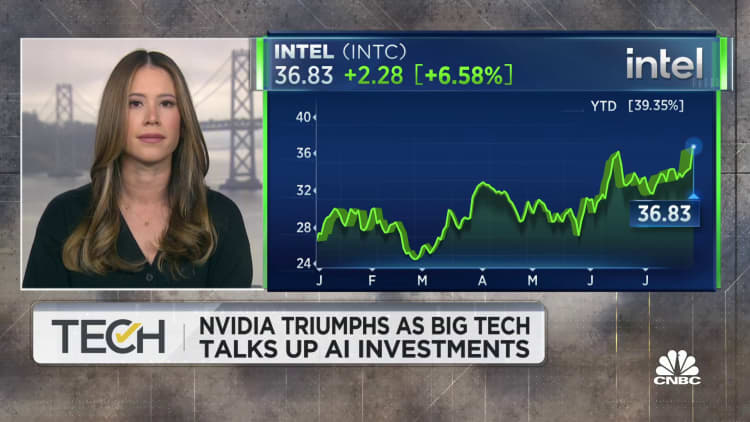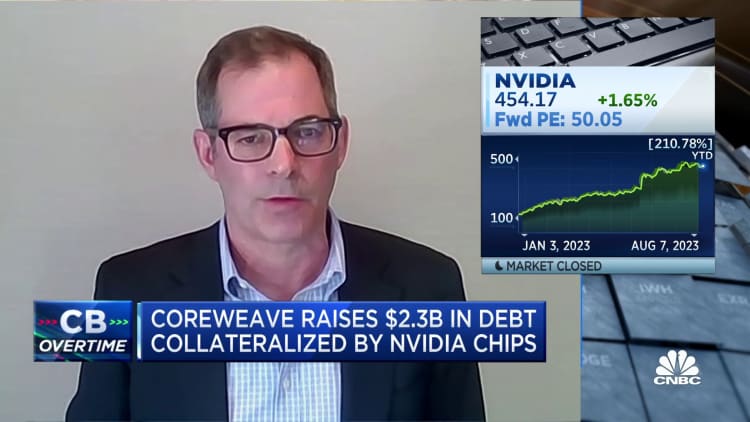
Nvidia CEO Jensen Huang,speaks at the Supermicro keynote presentation during the Computex conference in Taipei on June 1, 2023.
Walid Berrazeg | Sopa Images | Lightrocket | Getty Images
Following last year’s market route in tech stocks, all of the industry’s big names have rebounded in 2023. But one company has far outshined them all: Nvidia.
Driven by an over decade-long head start in the kind of artificial intelligence chips and software now coveted across Silicon Valley, Nvidia shares are up 180% this year, beating every other member of the S&P 500. The next biggest gainer in the index is Facebook parent Meta, which is up 151% at Friday’s close.
Nvidia is now valued at over $1 trillion, making it the fifth-most valuable U.S. company, behind only tech behemoths Amazon, Apple, Microsoft, and Alphabet.
While Nvidia doesn’t carry the household name of its mega-cap tech peers, its core technology is the backbone of the hottest new product that’s quickly threatening to disrupt everything from education and media to finance and customer service. That would be ChatGPT.
OpenAI’s viral chatbot, funded heavily by Microsoft, along with AI models from a handful of well-financed startups, all rely on Nvidia’s graphics processing units (GPUs) to run. They’re widely viewed as the best chips for training AI models, and Nvidia’s financial forecasts suggest insatiable demand.
The company’s powerful H100 chips cost around $40,000. They’re being swept up by Microsoft and OpenAI by the thousands.
“Long story short, they have the best of the best GPUs,” said Piper Sandler analyst Harsh Kumar, who recommends buying the stock. “And they have them today.”
Even with all that momentum and seemingly insatiable demand, baked into Nvidia’s stock price is a slew of assumptions about growth, including the doubling of sales in coming quarters and the almost quadrupling of net income this fiscal year.
Some investors have described the stock as priced for perfection. Looking at the last 12 months of company earnings, Nvidia has a price-to-earnings ratio of 220, which is stunningly rich even compared with notoriously high-valued tech companies. Amazon’s P/E ratio is at 110, and Tesla’s is at 70, according to FactSet.
Should Nvidia meet analysts’ projections, the current price still looks high compared to most of the tech industry, but certainly more reasonable. Its P/E ratio for the next 12 months of earnings is 42, versus 51 for Amazon and 58 for Tesla, FactSet data shows.
When Nvidia reports earnings later this month, analysts expect quarterly revenue of $11.08 billion, according to Refinitiv, which would mark a 65% increase from a year earlier. That’s slightly higher than Nvidia’s official guidance of about $11 billion.
Investors are betting that, beyond this quarter and the next, Nvidia will not only be able to ride the AI wave for quite some time, but that it will also power through growing competition from Google and AMD, and avoid any major supply issues.
There’s also the risks that come with any stock flying too high too fast. Nvidia shares fell 8.6% this week, compared to a 1.9% slide in the Nasdaq, with no bad news to cause such a drop. It’s the steepest weekly decline for Nvidia’s stock since September of last year.
“As investors, we have to start wondering if the excitement around all the great things that Nvidia has done and may continue to do is baked into this performance already,” WisdomTree analyst Christopher Gannatti wrote in a post on Thursday. “High investor expectations is one of the toughest hurdles for companies to overcome.”
How Nvidia got here
Nvidia’s stock rally this year is impressive, but the real eye-popping chart is the one showing the 10-year run. A decade ago, Nvidia was worth roughly $8.4 billion, a tiny fraction of chip giant Intel’s market cap.
Since then, while Intel’s stock is up 55%, Nvidia’s value has ballooned by over 11,170%, making it seven times more valuable than its rival. Tesla, whose stock surge over that time has made CEO Elon Musk the world’s richest person, is up 2,279%.
Nvidia founder and CEO Jensen Huang has seen his net worth swell to $38 billion, placing him 33rd on the Bloomberg Billionaires index.
An Nvidia spokesperson declined to comment for this story.
Before the rise of AI, Nvidia was known for producing key technology for video games. The company, reportedly born at a Denny’s in San Jose, California, in 1993, built processors that helped gamers render sophisticated graphics in computer games. Its iconic product was a graphics card — chips and boards that were plugged into consumer PC motherboards or laptops.
Video games are still a big business for the company. Nvidia reported over $9 billion in gaming sales in fiscal 2023. But that was down 27% on an annual basis, partially because Nvidia sold so many graphics cards early in the pandemic, when people were upgrading their systems at home. Nvidia’s core gaming business continues to shrink.
What excites Wall Street has nothing to do with games. Rather, it’s the emerging AI business, under Nvidia’s data center line item. That unit saw sales rise 41% last year to $15 billion, surpassing gaming. Analysts polled by FactSet expect it to more than double to $31.27 billion in fiscal 2024. Nvidia controls 80% or more of the AI chip market, according to analysts.
Nvidia’s pivot to AI chips is actually 15 years in the making.
In 2007, the company released a little-noticed software package and programming language called CUDA, which lets programmers take advantage of all of a GPU chip’s hardware features.
Developers quickly discovered the software was effective at training and running AI models, and CUDA is now an integral part of the training process.
When AI companies and programmers use CUDA and Nvidia’s GPUs to build their models, analysts say, they’re less likely to switch to competitors, such as AMD’s chips or Google’s Tensor Processing Units (TPUs).
“Nvidia has a double moat right now in that they they have the highest performance training hardware,” said Patrick Moorhead, semiconductor analyst at Moor Insights. “Then on the input side of the software, in AI, there are libraries and CUDA.”
Locking in revenue and supply
As Nvidia’s valuation has grown, the company has taken steps to secure its lead and live up to those lofty expectations. Huang had dinner in June with Morris Chang, chairman of Taiwan Semiconductor Manufacturing Co.
TSMC, the world’s leading manufacturer of chips for semiconductor companies, makes Nvidia’s key products. After the meal, Huang said he felt “perfectly safe” relying on the foundry, suggesting that Nvidia had secured the supply it needed.
Nvidia has also turned into a heavyweight startup investor in the venture world, with a clear focus on fueling companies that work with AI models.
Nvidia has invested in at least 12 startups so far in 2023, according to Pitchbook data, including some of the most high-profile AI companies. They include Runway, which makes an AI-powered video editor, Inflection AI, started by a former DeepMind founder, and CoreWeave, a cloud provider that sells access to Nvidia GPUs.
The investments could give the company a pipeline of growing customers, who could not only boost Nvidia’s sales down the line but also provide a more diverse set of clients for its GPUs.
Some of the startups are putting numbers out that show the sky-high levels of demand for Nvidia’s technology. Kumar from Piper cited comments from CoreWeave management, indicating that the company had $30 million in revenue last year, but has $2 billion in business contracted for next year.
“This is the representation of demand for generative AI type applications, or for voice-search applications, or generally speaking, GPU applications,” Kumar said.
Nvidia is now coming close to the midpoint of its current GPU architecture cycle. The latest high-end AI chip, the H100, is based on Nvidia’s Hopper architecture. Hopper was announced in March 2022, and Nvidia said to expect its successor in 2024.
Cloud providers including Google, Microsoft and Amazon have said they’re going to spend heavily to expand their data centers, which will mostly rely on Nvidia GPUs.
For now, Nvidia is selling nearly every H100 it can make, and industry participants often grumble about how hard it is to secure GPU access following the launch of ChatGPT late last year.
“ChatGPT was the iPhone moment of AI,” Huang said at the company’s annual shareholder meeting in June. “It all came together in a simple user interface that anyone could understand. But we’ve only gotten our first glimpse of its full potential. Generative AI has started a new computing era and will rival the transformative impact of the Internet.”
Investors are buying the story. But as this week’s volatile trading showed, they’re also quick to hit the sell button if the company or market hits a snag.
— CNBC’s Jonathan Vanian contributed reporting.
WATCH: CoreWeave raises $2.3 billion in debt collateralized by Nvidia chips

